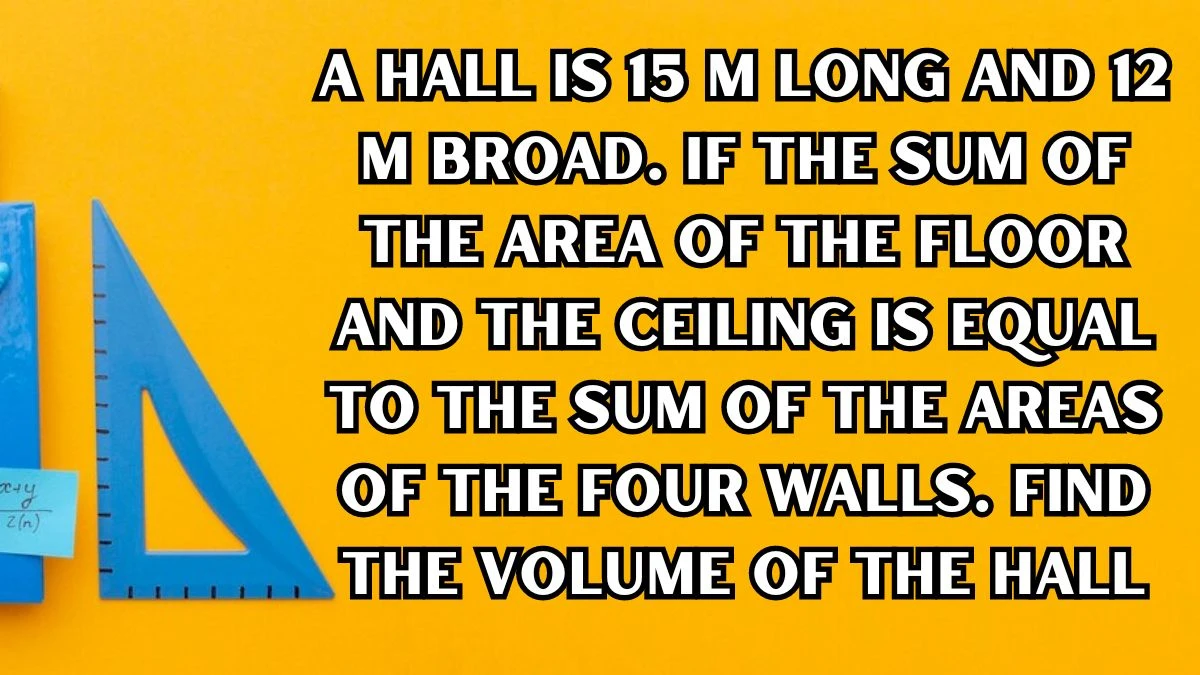A hall is 15 m long and 12 m broad. If the sum of the area of the floor and the ceiling is equal to the sum of the areas of the four walls. Find the volume of the hall
by
Updated Jun 11, 2024

A hall is 15 m long and 12 m broad. If the sum of the area of the floor and the ceiling is equal to the sum of the areas of the four walls. Find the volume of the hall
To find the volume of a hall with given dimensions and conditions, we need to use the relationships between the areas of the walls, floor, and ceiling.
Length of the hall (L) = 15 meters
Breadth of the hall (B) = 12 meters
The sum of the areas of the floor and the ceiling is equal to the sum of the areas of the four walls.
Identify the Area of the Floor and Ceiling:
The area of the floor = Length × Breadth
Since the ceiling has the same area as the floor:
Area of floor = 15 m × 12 m = 180 m²
Area of ceiling = 180 m²
Total area of floor and ceiling = 180 m² + 180 m² = 360 m²
Identify the Area of the Four Walls:
Let the height of the hall be h meters.
The area of the four walls can be calculated as:
Area of walls = 2 × (Length + Breadth) × Height
Area of walls = 2 × (15 m + 12 m) × h m
Area of walls = 2 × 27 m × h m
Area of walls = 54 h m²
According to the given condition, the sum of the area of the floor and the ceiling is equal to the sum of the areas of the four walls:
54 h m² = 360 m²
for Height h,
54h = 360
h = 20/3
Calculate the Volume of the Hall:
The volume of the hall is given by:
Volume = Length × Breadth × Height
Volume = 15 m × 12 m × 20/3 m
Volume = 15 × 12 × 6.67
Volume = 1200 m³
Volume and Surface Area of a Rectangular Hall
In mathematics, particularly in geometry, calculating the volume and surface area of various shapes is essential. For a rectangular hall, these calculations help determine how much space is inside the hall (volume) and the total area covered by its walls, floor, and ceiling (surface area).
Volume:
- The volume of a rectangular hall is the amount of space enclosed within it.
- It is calculated by multiplying the length, breadth, and height of the hall.
- Volume = Length × Breadth × Height.
Surface Area:
- The surface area of a rectangular hall includes the area of the floor, ceiling, and four walls.
- The area of the floor and ceiling can be calculated by multiplying the length and breadth.
- The area of the four walls is calculated by considering the sum of the length and breadth, multiplied by the height and then doubled.
Area of the Floor and Ceiling:
- These are identical in size and are found by multiplying the length and breadth.
- Total area of floor and ceiling = 2 × (Length × Breadth).
Area of the Four Walls:
- The walls form a rectangle, with the sum of the length and breadth forming the perimeter.
- The total area of the walls is calculated as 2 × (Length + Breadth) × Height.
Equating Areas:
- Sometimes, conditions are provided where the area of the walls must equal the combined area of the floor and ceiling.
- These conditions can be used to form equations to solve for unknown dimensions, such as the height.
Volume Calculation:
- Once all dimensions are known, the volume can be easily calculated using the volume formula.




